Now Reading: Safeguarding Businesses from AI-driven Cyber Threats
-
01
Safeguarding Businesses from AI-driven Cyber Threats
Safeguarding Businesses from AI-driven Cyber Threats

Safeguarding Businesses from AI-driven Cyber Threats
Introduction
In today’s ever-changing digital landscape, the rise of AI-driven cyber threats is causing significant concern for organizations worldwide. Businesses are under constant siege from AI cyber attacks that leverage cutting-edge technologies to bypass traditional defenses. As cybercriminals harness the power of artificial intelligence, cybersecurity professionals are being pushed to evolve their strategies quickly. This article delves into how AI-driven cyber threats are transforming the cybersecurity arena, explores advanced tactics such as automated reconnaissance and deepfake cyber attacks, and highlights proactive measures to counter these risks.
Understanding the New Era of Cyber Attacks
The integration of artificial intelligence in cyber criminal activities has dramatically reshaped the threat paradigm. With AI’s ability to learn and adapt, attackers now employ sophisticated methods that outpace conventional security measures. Key aspects of this evolving threat landscape include:
- Advanced automated reconnaissance: Attackers use AI to scan networks rapidly, identifying vulnerabilities that would typically require manual effort.
- Deepfake cyber attacks: By creating realistic simulated identities, hackers deceive even skilled professionals.
- Precision targeting: AI transforms the process of identifying and exploiting weak points, increasing the success rate of cyber breaches.
Evolution of AI-driven Cyber Threats
Automated Reconnaissance and Adaptive Tactics
AI-driven tools now allow threat actors to perform automated reconnaissance on networks. These tools can rapidly collect data, analyze system vulnerabilities, and even predict changes in security configurations in real time. The ability to modify tactics on-the-fly ensures that cyber criminals stay a step ahead of their targets.
Deepfake Cyber Attacks and Phishing Schemes
Deepfake technology, once used mainly in media, now plays a critical role in cyber attacks. Attackers generate convincing fake identities and fraudulent communications, making it increasingly difficult to discern genuine alerts from deceptive ones. This level of sophistication necessitates new verification protocols and stronger authentication measures.
Real-time AI Cyber Attacks
The speed at which AI cyber attacks can be deployed is astonishing. Algorithms continuously learn from each attempt, optimizing their methods to evade detection. This has led to a scenario where traditional antivirus software and firewalls may not be enough to mitigate the risk. As a result, modern cybersecurity strategies must incorporate real-time monitoring capabilities fortified by artificial intelligence.
Case Studies: How AI Transforms Cyber Threats
One illustrative case involves the rapid mapping of a corporate network using automated reconnaissance. In this scenario, AI tools identified multiple vulnerabilities within minutes, allowing hackers to configure a tailored attack strategy. This case underscores the long-tail keyword, “how AI transforms cyber threats,” demonstrating that the efficiency of AI in reconnaissance directly translates to more efficient and damaging breaches. Additionally, documented instances of AI arms races in cybersecurity illustrate that defensive measures need to be equally advanced. For instance, Check Point, a leader in the security industry, provides regular insights into these trends. Visit Check Point’s official website for more authoritative reports.
Strategies to Counteract AI-driven Malware
- Embrace AI-powered defense systems: Use machine learning and predictive analytics to identify anomalies in real time.
- Invest in continuous staff training: Regular updates and training programs help staff stay informed and prepared.
- Collaborate with experts: Sharing information on emerging threats within the cybersecurity community can lead to more effective countermeasures.
- Regularly update systems: Ensure that security patches are deployed promptly to combat newly discovered vulnerabilities.
The AI Arms Race in Cybersecurity
Another important aspect of this evolving landscape is the AI arms race in cybersecurity. As hackers take advantage of AI, security firms are also investing in advanced technologies. This creates a complex battlefield where offensive innovations are rapidly met with defensive solutions. Keywords such as “AI arms race in cybersecurity” and “counteracting AI-driven malware” emphasize this ongoing struggle. Companies are urged to constantly evaluate their cybersecurity frameworks and adopt adaptive, future-proof solutions.
Conclusion
The era of AI-driven cyber threats is fundamentally reshaping the security landscape. With the ability to deploy rapid, precise, and evolving attacks, cyber criminals now represent a formidable challenge that requires dynamic and innovative defenses. From automated reconnaissance and deepfake cyber attacks to sophisticated AI-driven malware, the threat is real and growing. However, by leveraging AI to bolster cybersecurity measures, investing in robust training, and updating systems, organizations can build a resilient defense against these advanced threats.
As the digital battleground continues to evolve, vigilance, collaboration, and innovation remain key. The journey to safeguard business assets against AI-driven cyber threats is not only a technical challenge but also a strategic imperative. By understanding the nuances of these attacks and committing to continuous improvement, the cybersecurity community can work together to turn the tide in this modern digital arms race.

























